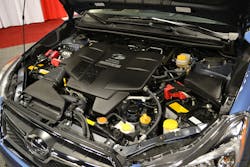University of Extrication: New Technology Update 2015, Part 3
SUBJECT: New Technology Update 2015, Part 3
TOPIC: New Vehicle Technology Features
OBJECTIVE: Recognition & Familiarization with New Vehicle Features, Operating Systems, & Components
TASK: When confronted with new vehicle features, operating systems, and components, the rescue team shall recognize these systems and implement appropriate safety procedures to deal with these systems
Part 3 of this University of Extrication series looks at selected new features that may be found on late-model vehicles at a crash or fire scene. In particular, we discuss a new hybrid vehicle with dual 12-volt batteries, look at a new vehicle badging logo, as well as explain new vehicle changes that are appearing with vehicle airbag restraint systems.
Photo 1. The Subaru XV CrossTrek hybrid has two 12-volt batteries under the hood because it has an engine Auto Stop/Start feature. A driver’s-side battery powers all 12-volt accessories. A passenger’s-side battery powers the integrated starter generator for the Auto Stop mode. Both must be disconnected or have cables cut to power down all of the 12-volt electrical system. The 100-volt nickel-metal hydride battery is in the rear.
Photo 2. PZEV badging on a vehicle does not indicate the presence of a hybrid or electric plug-in vehicle. It does indicate that the vehicle meets special restrictive government exhaust emission standards. This Subaru Impreza is not a hybrid or electric plug-in; it has a 2.0L gasoline engine.
Photo 3. An increasing 2014-2015 model-year trend is the “seat cushion” airbag. In addition to a side-impact airbag in the outboard edge of a seat, a small airbag may now be present beneath the front edge of just the seat cushion. The front edge of the cushion lifts during a frontal collision to restrain the occupant from moving forward. Note two airbag IDs on this seat, although there are no requirements to label or identify any airbags in a vehicle.
Photo 4. Rear-seat inflatable seatbelt airbags continue and expand into additional Ford, Lincoln and Mercury models. Be alert for a thicker seatbelt and a large, tubular-looking metal buckle. The inflator at the base of each female buckle will deploy only if the belt is buckled at the time of the collision. Mercedes-Benz uses a similar inflatable rear seatbelt airbag system.
Photo 5. On Ford, Lincoln and Mercury models, look near the top edge of the seat for the airbag ID indicating the presence of the inflatable seatbelt system. If it is not inflated, unbuckle it from the occupant. If inflated, unbuckle it normally or the beltbag can be cut through without issue.
Photo 6. Kneebags become more and more common in 2015 model-year vehicles. Responders will be challenged to detect their presence due to their low and, in most cases, concealed locations. The passenger kneebag on this Mercury MKZ is completely beneath the glove compartment.
Photo 7. Airbag IDs are not required at all. When present, the kneebag ID will be found in the same color as the instrument panel, making it difficult to see, as shown above. When kneebags are present, kneebag stored-gas inflators are present and important for rescuers to know about when accomplishing dash- jacking or dash-rolling evolutions.
Photo 8. This 2014 Buick Encore SUV has rear-seat side-impact airbags; however, they are not where responders may think they are. A close look shows the rear-seat airbag ID along the upper area of the black trim. The rear seatbacks on the Encore, as on many SUVs, fold forward, allowing for increased space in the cargo area.
Photo 9. What responders may not expect is that although the rear seatback is folded flat, the rear-seat side-impact airbag remains upright. This is possible because the airbag unit and its stored-gas inflator are housed inside the small, side-seat cushion that remains upright along the very edge of the door opening.
Photo 10. Responders must now train to be more observant of labels along door openings. This 2015 Toyota Corolla has white and yellow labels on the B-pillar at the front door opening to advise that side-impact airbags are present in this driver’s seat.
Photo 11. This B-pillar label is in addition to a black-on-black seat airbag ID on the seat molding itself. These labels, although of value to responders, are present to advise consumers about the risk of leaning against the door when a seat airbag deploys.
New Technology, Part 3
- Subaru XC CrossTrek Hybrid Dual Batteries
- PZEV Badging
- Seat Cushion Airbags
- Rear Inflatable Seatbelt Airbag
- Kneebags & Kneebag IDs
- Rear Seat Airbags
- Airbag Pillar Labels
Read the rest of the series here:
Part 1: Recognition & familiarization with new vehicle features, operating systems, & components
Part 2: Implement procedures for modern features

Ron Moore
RON MOORE, who is a Firehouse contributing editor, recently retired as a division chief with the McKinney, TX, Fire Department and now serves with Prosper, TX, Fire Rescue. He self-published the Vehicle Rescue 1-2-3 training manual and serves as the forum moderator for the extrication section of Firehouse.com . Moore can be contacted directly at [email protected].






